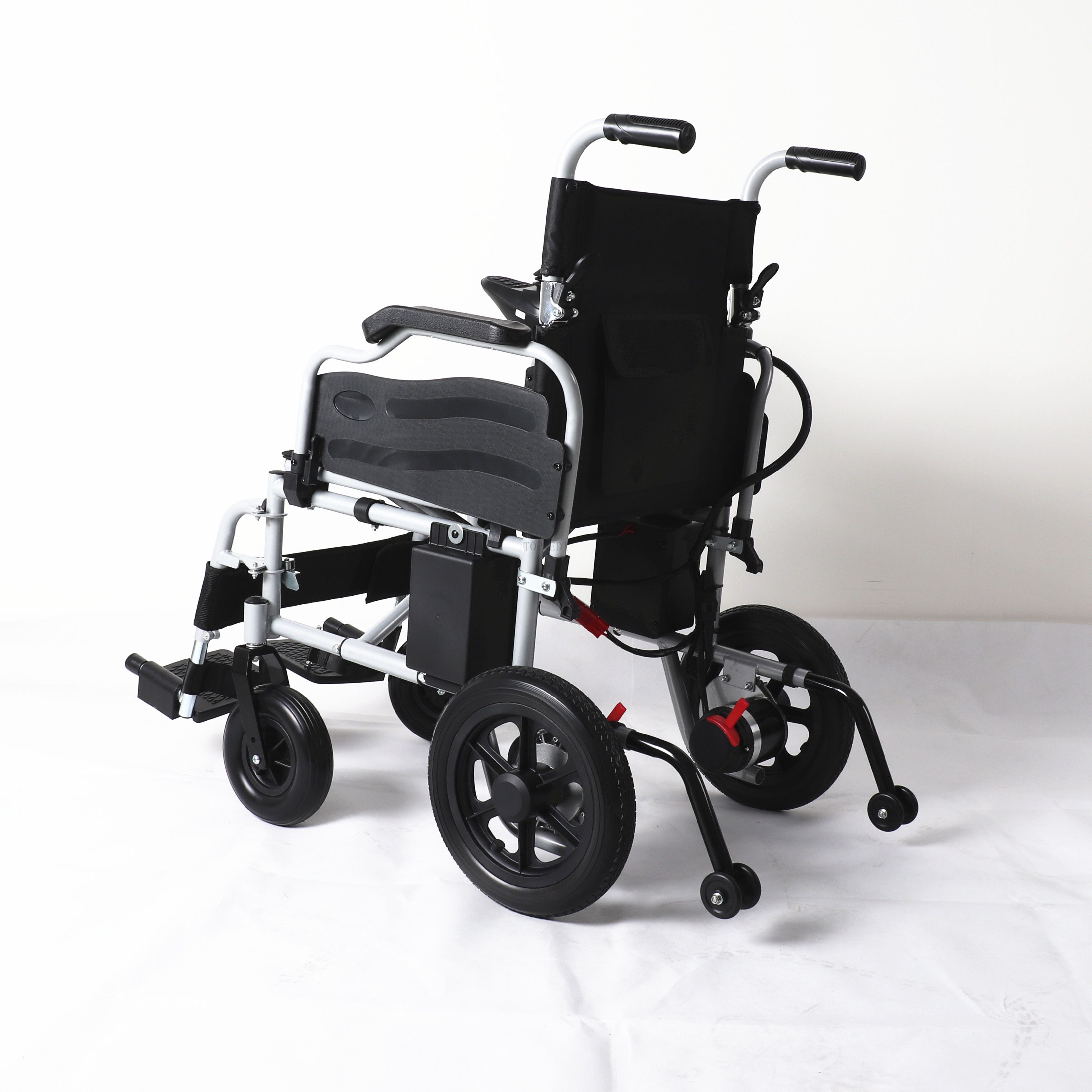Introduction
Are you curious about how many batteries your electric wheelchair needs? Understanding this is crucial for both performance and longevity.
In this post, we’ll explore how the number of batteries impacts your wheelchair’s range and efficiency. You’ll also learn about different battery types and configurations, and why proper maintenance is essential for optimal performance.

Electric Wheelchair Battery Overview
The Role of Batteries in Electric Wheelchairs
Batteries are at the heart of every electric wheelchair. They power the motors that drive the wheels, the controls that allow users to navigate, and additional features like seat adjustments or lights. Without a functional battery, none of these systems would work.
Electric wheelchairs rely on battery systems to provide the necessary power to move, making them crucial for maintaining mobility. The performance of a wheelchair—such as speed, distance, and stability—depends entirely on the battery’s capacity and efficiency.
Different types of batteries, such as lead-acid or lithium-ion, influence how well the wheelchair performs. For example, lithium-ion batteries are lightweight and efficient, while lead-acid batteries tend to be heavier but are more affordable. The choice of battery affects both the user's experience and the wheelchair's performance over time.
What Affects the Number of Batteries in an Electric Wheelchair?
Several factors determine how many batteries are needed for an electric wheelchair. These include the wheelchair’s intended use, the user's weight, and the terrain it will be used on.
Wheelchair Type: Smaller, lightweight wheelchairs for indoor use may only need one battery, while larger models designed for outdoor use may require two or more.
Terrain: Wheelchairs used on rough or hilly terrain need more power, which is often achieved by using multiple batteries.
User Weight: Heavier users demand more power for movement, so a dual battery setup is common to ensure efficient performance.
Power Needs: A wheelchair that needs to travel longer distances or maintain higher speeds will typically require a dual or custom battery setup to meet these demands.
For example, a single battery is sufficient for short indoor trips, but a dual battery setup is better for users who need to travel over longer distances or uneven surfaces. Performance demands, such as faster speeds and higher torque, also influence the decision to opt for a more powerful battery configuration.
Here’s a quick breakdown of factors that impact the number of batteries:
| Factor | Impact on Battery Configuration |
| Wheelchair Type | Smaller models need one, larger need two+ |
| Terrain | Rough terrains require more battery power |
| User Weight | Heavier users need additional power |
| Power Needs | Long distances, higher speeds need more power |
By understanding these factors, users can choose the right battery configuration to match their needs.
Types of Batteries Used in Electric Wheelchairs
Lead-Acid Batteries
How Do Lead-Acid Batteries Work?
Lead-acid batteries are the most common and affordable option for electric wheelchairs. They’re widely used in budget-friendly models due to their lower upfront cost. These batteries consist of lead plates and sulfuric acid to store energy, which powers the wheelchair.
Pros:
Low initial cost
Widely available
Reliable for basic usage
Cons:
Where Are Lead-Acid Batteries Used in Electric Wheelchairs?
Lead-acid batteries are typically found in entry-level wheelchairs or models designed for short indoor use. They’re perfect for people who need a simple, affordable wheelchair for daily tasks around the home. However, they aren’t ideal for long distances or rough terrain, as their heavier weight and limited range can be restrictive.
Lithium-Ion Batteries
Benefits of Lithium-Ion Batteries
Lithium-ion batteries are known for being lightweight, long-lasting, and efficient. These batteries are the go-to choice for most modern electric wheelchairs. They’re typically used in higher-end models that prioritize performance and longevity.
Pros:
Cons:
Why Choose Lithium-Ion Batteries for Your Electric Wheelchair?
Lithium-ion batteries are perfect for users who require better performance, longer distances, and minimal maintenance. They are especially valuable for people who use their wheelchair frequently and need it to perform well in various environments. Though more expensive upfront, lithium-ion batteries offer great long-term value due to their longevity and efficiency.
Nickel-Metal Hydride (NiMH) Batteries
NiMH Batteries Explained
NiMH batteries are an option between lead-acid and lithium-ion batteries. They offer a balance of performance and cost, being lighter than lead-acid but still affordable compared to lithium-ion.
Pros:
Cons:
How Does NiMH Compare to Lead-Acid and Lithium-Ion Batteries?
NiMH batteries perform better than lead-acid batteries in terms of weight and efficiency, but they don’t last as long as lithium-ion. They are a good middle ground for those who want something more efficient than lead-acid but don’t need the long lifespan or fast charging of lithium-ion.
Lithium-Polymer (LiPo) Batteries
Understanding Lithium-Polymer Batteries
Lithium-polymer (LiPo) batteries are similar to lithium-ion batteries but use a polymer electrolyte instead of liquid. This makes them more flexible and compact. While they offer higher capacity in a smaller package, they can be more sensitive to overcharging.
Pros:
Cons:
When Are Lithium-Polymer Batteries Used in Electric Wheelchairs?
LiPo batteries are often used in ultra-lightweight wheelchairs or those that require a high energy density in a compact form. They’re ideal for specialized models or wheelchairs that need to be extremely lightweight without sacrificing power. However, their sensitivity means that proper charging and maintenance are critical.
Here’s a comparison of different battery types used in electric wheelchairs:
| Battery Type | Pros | Cons | Use Case |
| Lead-Acid | Low cost, widely available | Heavy, shorter lifespan | Budget models, indoor use |
| Lithium-Ion | Lightweight, long lifespan, fast charge | Higher initial cost | High-performance, long-distance |
| NiMH | Lighter than lead-acid, eco-friendly | Shorter lifespan than lithium-ion | Mid-range models, eco-conscious |
| Lithium-Polymer | Lightweight, high capacity | Expensive, sensitive to overcharging | Ultra-lightweight, specialized use |
These battery types are designed for different needs and budgets, offering various trade-offs between weight, lifespan, charging time, and cost.
Maintaining Your Electric Wheelchair’s Battery System
Battery Charging and Maintenance Tips
How to Charge Your Wheelchair Battery Properly?
Charging your wheelchair battery correctly is essential for maintaining its performance and longevity. Always use the charger recommended by the manufacturer to avoid damaging the battery. Overcharging can shorten the battery’s life, so it’s important to avoid leaving it plugged in too long.
Charging Frequency: Ideally, charge your battery when it’s about 30% to 40% drained. Don’t wait until it’s completely empty. This helps maintain the battery’s efficiency.
Storage: If you won’t be using your wheelchair for a while, store the battery in a cool, dry place. Charge it every couple of months to keep it from discharging completely.
Regular Maintenance Practices
Taking care of your battery’s physical condition is just as important as charging it properly. Here are some simple maintenance tips:
Cleaning Battery Terminals: Over time, battery terminals can accumulate dirt or corrosion. Clean them regularly to ensure a good connection.
Checking for Damage: Inspect the battery and wiring for any visible signs of wear, such as cracks or leaks. If the battery is damaged, it may need to be replaced.
You should also regularly check the wheelchair’s performance. If it’s struggling to hold a charge or is charging unusually slowly, it could be time for a replacement.
How Long Do Electric Wheelchair Batteries Last?
Battery Lifespan and Replacement
The lifespan of your wheelchair battery depends on the type and how well it’s maintained.
Lead-Acid Batteries: These typically last around 1-2 years. They are cheaper upfront but need replacing more frequently.
Lithium-Ion Batteries: Known for their long lifespan, lithium-ion batteries can last anywhere from 3-5 years.
NiMH Batteries: These generally last 2-3 years, making them a middle ground between lead-acid and lithium-ion in terms of cost and longevity.
It’s important to replace your battery when its performance starts to degrade. Generally, you should replace your battery every 1-5 years, depending on the type.
Signs That Your Battery Needs Replacing
Here are some common signs that your battery may need replacing:
Decreased Range: If your wheelchair can no longer travel as far as it used to on a single charge, this could indicate that the battery is losing its capacity.
Frequent Recharging: If you need to charge your battery more often than before, it might be losing efficiency.
Slow Charging: If the battery is taking longer to charge than usual, it may no longer hold a full charge.
Physical Signs of Damage: Check for any signs of swelling, leakage, or cracks. These could be signs of a damaged battery that needs immediate replacement.
Here’s a quick summary of battery types and their typical lifespan:
| Battery Type | Average Lifespan | Signs to Replace |
| Lead-Acid | 1-2 years | Decreased range, slow charging |
| Lithium-Ion | 3-5 years | Frequent recharging, swelling |
| NiMH | 2-3 years | Reduced distance, slow charge |
Regular maintenance and proper charging habits will help extend the life of your battery and ensure your electric wheelchair continues to perform at its best.
Conclusion: Choosing the Best Battery Setup for Your Electric Wheelchair
When selecting a battery for your electric wheelchair, consider the type, range, and performance needs. Think about how often you’ll use it and the terrain.
Before making a decision, weigh factors like battery type, user weight, and charging requirements. Choose a battery that fits both your immediate and long-term needs for optimal performance and reliability.
















